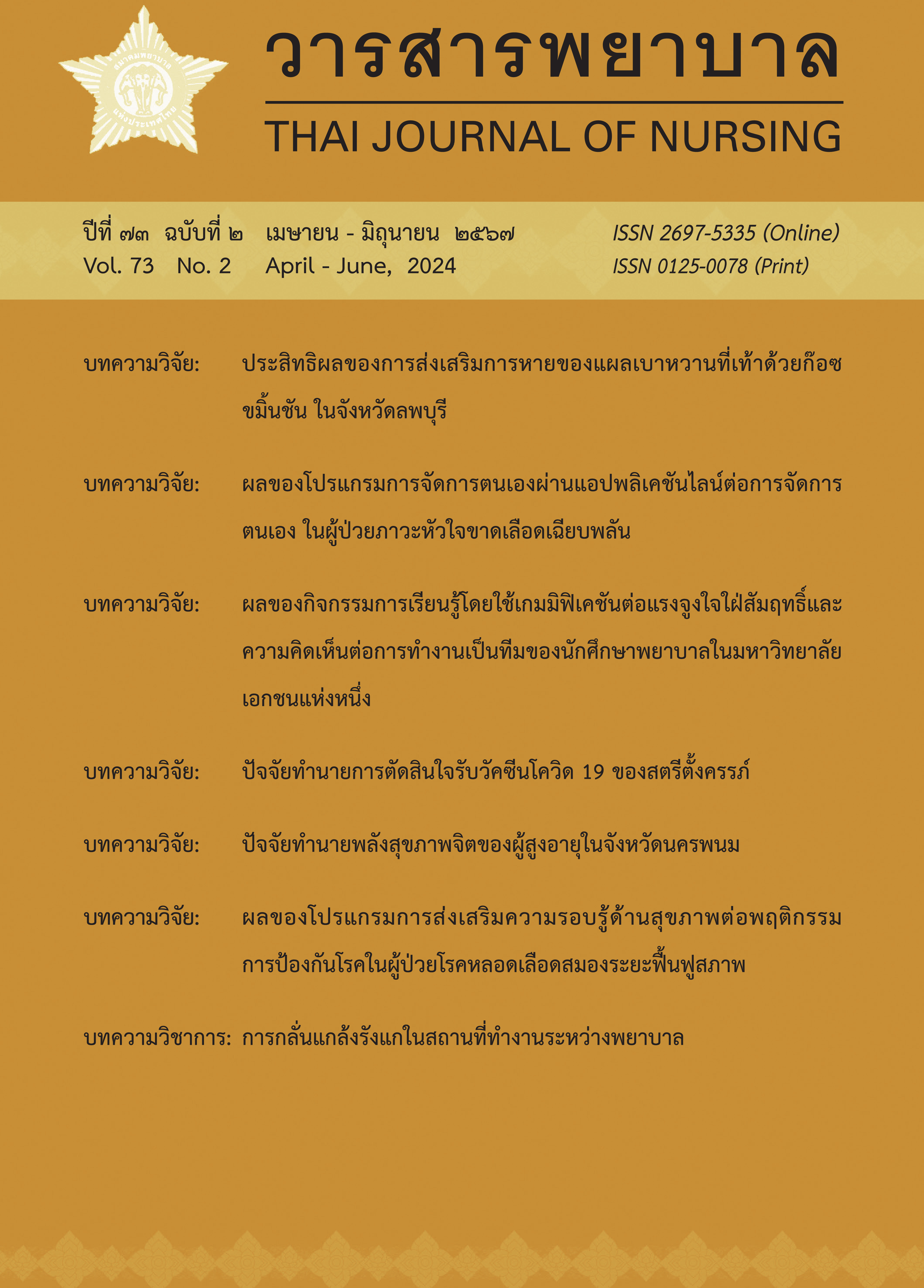Effectiveness of promoting the healing process of diabetic ulcers with curcumin gauzes in Lopburi Province
Main Article Content
Abstract
The purpose of this quasi-experimental research was to study the effectiveness of promoting the healing process of diabetic ulcers (DU) with curcumin gauzes in Lopburi Province. A group of 64 diabetic patients with DU was purposively selected from Pattananikom Community Hospital to be an experimental group and from Thaluang Community Hospital to be a comparison group, 31 person in each group. The research tools were promoting the healing process of DU with curcumin gauzes, and the severity of open wound assessment form (OWAF). The content validity index and interrater reliability coefficient of OWAF were equal to 0.93. Data were analyzed by descriptive statistics, Chi-square test, Independent t-test, Proportional test, and Mann-Whitney U test. The results revealed as follows. 1) After 4 weeks, the experimental group had significantly higher healing rate of DU compared to the comparison group, and DU had healed significantly faster than the comparison group (p <.001). 2) In the 2nd, 3rd, and 4th week, the experimental group had significantly lower mean score of wound severity compared to the comparison group (p < .01). 3) The experimental group had mean rates of decrease in width, length, depth of DU per week and decrease in DU circumference per week that were significantly greater than the comparison group, and mean of wound contraction per week that was significantly more than the comparison group (p <.001). Finally, 4) The mean material cost in wound dressing of the experimental group was significantly less than the comparison group (p <.001).
Article Details

This work is licensed under a Creative Commons Attribution-NonCommercial-NoDerivatives 4.0 International License.
References
กุญช์ภัช จันทรัตน์ และ พวงทอง สมป่าสัก. (2561). นวัตกรรมเรื่อง ก๊อซขมิ้นชันรักษาแผล.
http://kpo.go.th/webkpo/Summarymeeting/BS_6211_Kosamphee.pdf
กระทรวงสาธารณสุข สำนักโรคไม่ติดต่อ. (2563). รายงานประจำปี 2562. กระทรวงสาธารณสุข.
http://thaincd.com/document/Ġf ile/download/paper- manual/Annual-report-2019.pdf
กุสุมา กำจร. (2548). การเปรียบเทียบการหายของแผลที่เท้าระหว่างการทำแผลด้วยครีมเปลือกมังคุดกับการทำแผลแบบเปียกด้วยน้ำเกลือนอร์มัลในผู้ป่วยเบาหวาน (วิทยานิพนธ์ปริญญามหาบัณฑิต ไม่ได้ตีพิมพ์). มหาวิทยาลัยมหิดล.
ชัยพร กลิ่นจันทร์. (2560, 6-10 กรกฎาคม). นวัตกรรมในการใช้ก๊อซขมิ้นชันบาบัดแผลสดในจังหวัดลพบุรี. ในการประชุมวิชาการทางการแพทย์แผนไทยและการแพทย์ทางเลือก กระทรวงสาธารณสุข. ณ ศูนย์แสดงสินค้า และการประชุมอิมแพ็ค เมืองทองธานี.
ภูดิศ สะวิคามิน. (2555). Off loading ด้วยนวัตกรรม felted foam กับระยะเวลาและความคุ้มค่าในการรักษาแผลที่เท้าผู้ป่วยเบาหวาน ชนิด 1 A. R2R ของสำนักงานสาธารณสุขจังหวัดบึงกาฬ.
https://bkpho.moph.go.th/ssjweb/bkresearch/files/post-doc/20170109112802.pdf
โรงพยาบาลพระนารายณ์มหาราช งานเวชระเบียน. (2563). สรุปรายงานผู้ป่วยคลินิกเบาหวานปีงบประมาณ 2558. โรงพยาบาลพระนารายณ์มหาราช.
อภิรักษ์ ช่วงสุวนิช และ พิตะวัน ราชตา. (2561). Wound healing process. ใน อภิรักษ์ ช่วงสุวนิช, กมลวรรณ เจนวิถีสุข และสุภาพร โอภาสานนท์ (บ.ก.), Essential in wound management (น. 1-8). คลังนานาวิทยา.
Acharya, A. M., Sunkara, S. B., & Panda, B. B. (2020). Turmeric mixed honey topical application enhances healing is safe and economical in chronic wounds. Journal of Evidence Based Medicine and Health, 7(28), 2349-2562.
Desmouliere, A., Geinoz, A., Gabbiani, F., & Gabbiani, G. (1993). Transforming growth factor-beta 1 induces alpha-smooth muscle actin expression in granulation tissue myofibroblasts and in quiescent and growing cultured fibroblasts. Journal of Cell Biology, 122(1), 103–111. https://doi.org/10.1083/jcb.122.1.103
Kant, V., Gopal, A., Pathak, N., Kumar, P., & Tandan, K. S. (2014). Antioxidant and anti inflammatory potential of curcumin accelerated the cutaneous wound healing in streptozotocin-induced diabetic rats. International Journal of Immunopharmacology, 20(2), 322-330. https://doi.org/10.1013/j.intimp.2014.03.009
Kanogsunthornrat, N., Srisupan, W., Pothiban, L., Srimuninmimitr, V., & Wonghongtul, W. (2006). Feasibility and acceptability of a wound care program using a portable vacuum bottle dressing for open wound healing. Thai Journal of Nursing Research, 10, 29-45.
Liang, G., Yang, S., Zhou, H., Shao, L., Huang, K., Xiao, J., Huang, Z., & Li, X. (2009). Synthesis, crystal structure and anti-inflammatory properties of curcumin analogues. European Journal of Medicinal Chemistry, 44(2), 915–919. https://doi.org/101016/j.ejmech.2008.01.031
Meng, B., Li, J., & Cao, H. (2013). Antioxidant and antiinflammatory activities of curcumin on diabetes mellitus and its complications. Current Pharmaceutical Design, 19(11), 2101-2113.
https://doi.org/10.2174/138161213805289318
Mohanty, C., Das, M., & Sahoo, S. (2012). Sustained wound healing activity of curcumin loaded qleic acid based polymeric bandage in a rat model. Molecular Pharmaceutics, 9(10), 2801-2811.
https://doi.org/10.1021/mp300075u
Mun, S. H., Joung, D. K., Kim, Y. S., Kang, O. H., Kim, S. B., Seo, Y. S., Kim, Y. C., Lee, D. S., Shin, D. W., Kweon,. K. T., & Kwon, D. Y. (2013). Synergistic antibacterial effect of curcumin against methicillin-resistant staphylococcus aureus. Phytomedicine, 20(8-9), 714-718.
https://doi.org/10.1013/j.phymed.2013.02.006
Nguyen, V. C., Nguyen, V. B., & Hsieh, M. F. (2013). Curcumin-loaded chitosan/gelatin composite sponge for wound healing application. International Journal of Polymer Science, Article 106570. https://doi.org/10.1155/2013/106570
Rajinder, R., & Verma, P. K. (2008). The efficacy of turmeric powder on diabetic foot ulcers healing. section B: Literature related to turmeric for wound healing. https://nursinganswers.net/essays/review-of-literature-on-turmeric-for-wound-healing-nursing-essay.php
World Health Organization. (2015). Fact sheet: Diabetes. http://www.who.int/ ediacentre/factsheets/fs312/en/


